By Cameron B.
If I am one thing it is a lover of practical history. If I’m two things I’m a history lover and a hopeless tinker. I’m not sure if growing up in a non-gun family (in Massachusetts!) was cause for my historical justification of firearms, or that my father built heavy timber houses with hand tools that dated back to the turn of the century. But classic guns have always been the staple of my firearms hobby and occasionally the bane of my discussions with friends of ARs vs. M1s. My champagne tastes for classic Mausers and American ’03s were slighted by being 23, married and putting my saintly, patient wife through nursing school. What any sane man would have done was buy a Mosin Nagant and be happy with my C&R purchase. But John Henry Patterson (Lions of Tsavo) and Hesketh-Pricharrd (WW1 British sniping instructor) called to me. Enter the SMLE . . .
Upon development of the Lee-Metford rifle the commonwealth was forever trying to perfect a fantastic design this lead to the Lee-Enfield mk1,2,3,3* then the SMLE No4 Mk1 where my rifle’s life began. The Short Magazine Lee-Enfield or SMLE or “smelly” is a bolt-action rifle chambered in the .303 British caliber feed from a (kind of) detachable 10 round box magazine.
This rifle also utilizes a “push-to-cock” bolt system; meaning that the last half-inch of forward cycling charges the rifle. This atypical action paired with the large capacity lead to the “mad minute”. The mad minute was a practice where British soldiers would be required to fire 30 shots – that’s the magazine plus four stripper clips – and score at least 15 hits on a pie plate at 300 yards. Oh yeah, all under a minute! Imagine a squad of trained soldiers laying down that level of fire when automatic rifles were barely employed.
I would like to say that if you are a purist of classic guns, you might want to read one of the other wonderful reviews on this site, this is not a from the trenches battle rifle. Some would consider this rifle an abomination being “sporterized,” the process of turning a combat rifle like an SMLE into a hunting or target rifle. “Sporters” range from basement hack jobs or “bubba guns” to fine rifles that were produced by companies like Griffin and Howe.
My rifle is somewhere between those areas. Sporterizing was done when these guns were dirt-cheap and folks who couldn’t afford to chase deer and elk with Winchesters or the new bolt guns bought 1903s, Krags, Mausers, and Enfields with the truckloads of milsurp ammo. These rifles did shoot and then men did feast. These bring backs and ugly ducklings were left in closets and backseats until they made their way to gun shows, shops, and auctions. I look at these guns as an opportunity to keep the memory of these guns alive and give them a second life.
While I’d never advocate taking a drill and saw to a “pure” rifle saving one of these odd jobs gives a project that in the long run might be cheaper than buying a new Sako-Rem-chester-magnum. I own a beat up Land Cruiser that’s older than me for this same purpose. How often do you get to use an item that has been around the world and been around for number of decades longer than you? And how cool will it be when you can turn this rusted unloved pile of steel into a fine tuned machine you put your time and effort into?
Overall appearance
I fell in love with the look of this rifle when it first sprung up online. When I pleadingly showed my wife her response was “I like that one.” Bonus! Whoever sporterized this rifle took their time and it’s certainly not the Friday afternoon work you can see on some guns. The jeweled bolt is a nice touch. I don’t own many stocks with maple inlays and while the walnut might not be presentation grade, it’s moot when I remember that this rifle has maple inlays and very nice checkering. This rifle turns heads when you step on the range. Frankly stepping onto the range with any Enfield is bound to get a few looks, it’s not every day you see a magazine fed bolt gun than isn’t an M700.
Fit and finish
I’ve yet to find a complaint about the rifle. Perhaps we can whine about the odd two-piece stock that every Enfield employs. More parts mean more possibility for loosening.
Ease of use
The push-to-cock action can be a stumbling block. It does feel a little awkward for the first few shots. That being said, you can pretty quickly see how a mad minute drill could be a lot of fun.
Ease of disassembly
The bolt of this gun is…an absolute bugger to remove. It requires some correct placement then manhandling and possible removal of fingernails. There is no bolt-release button as there would be on a modern hunting rifle. The bolt is removed by bringing the bolt to the rear and pulling up on the bolt head; after the head is upright the bolt slides out the back of the receiver and can be cleaned from there. This gun wasn’t made to be easy to strip and being a bolt gun there shouldn’t be much need after the bolt is out.
Handling characteristics
This rifle points nimbly and will serve me well out in the field. In its original configuration, the No.4 was a beefy rifle but is still more comfortable (to me) than a Mosin. These rifles have two-stage triggers. I have no idea what mine pulls at but its uptake is smooth with a clean let-off. As I mentioned earlier, the magazine is removable; but it was only intended to be removed for cleaning as it requires more than two hands pry off. The safety is located on the left side of the receiver. Engaging the safety (rearward) locks the bolt in place. For a right handed user this operation shouldn’t be to difficult.
A comparison of the Enfield vs. my Winchester:
Application
Another reason I fell in love with the .303Brit is that it has been to and taken game on every continent. From moose and bear in Canada, to ‘roos in the Outback. It’s probably taken a few elephants though this isn’t my idea of a bright idea. With a variety of ammo ranging from 123-215 grains, it’s more than suited for anything you can find in North America though I’d probably not hunt big bears with it. This rifle will be my main bacon and venison harvesting tool when the season roles around. A synthetic stock might make this gun a little lighter and perhaps would fit the role of a bug out/ survival rifle: the one caveat is that the ammo is at least in my neck of the woods not as common as 30-06 or .270 head north to Canada and it’ll be more common.
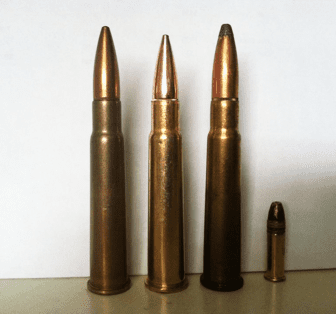 Milsurp 174gr, Remington 174gr, reloaded 180 gr, 22lr
Milsurp 174gr, Remington 174gr, reloaded 180 gr, 22lr
Aftermarket parts are an interesting point. Scope mounting is about all that “needs” to be done, and with a non-molested gun there are several “no drill” mounts for the Enfield. Mine requires a side mount due to the charging bridge being ground off for a more pleasing appearance. This leads to a hunt for parts more challenging than my ‘89 Land Cruiser. But hunt forums and eBay long enough and a headlight…I mean scope mount will turn up. Lower capacity magazine can be found with some browsing of larger distributors.
Favorite feature:
I love the action of this gun. Maybe I’ll have a revelation later in life that I couldn’t be more off but for me it’s the sweetest action I’ve used yet.
Least favorite feature:
Ammunition. As a new husband and sole supporter of my household, there’s not a whole lot of money for reloading. If I was in the game of reloading already then this would be no sweat, but I’m not finding cheap ammo in this…dry spell. It’s a wee bit frustrating. Privi along with Remington make ammo, but the savvy Enfielders got to them before I did. That being said, with its low sale velocity it often sticks on the shelf longer than 30-30 or .270.
Would it be a review without a Zombie?
Testing was done at East Orange Shooting Sports; one of the longest ranges in Orlando (a whopping 25 yards). To be fair it’s a great indoor range that allows rifles and shotguns. All shots were made off hand.
I used Remington “green box” 174gr MC ammo. The 174gr is the classic military load for the Enfield.
I was pretty giddy about this group. It might not be trophy winning, but the outlier was the first/fouling shot and I stacked the next two. Nothing about this gun is meant to be sub MOA. If I can consistently place lead in a few inches its good enough to harvest plenty of dinners.
Specifications:
Caliber: .303 British.
Barrel: 22″ after market four groove
Size: 40″
Weight: 8lbs unloaded
Operation: bolt
Finish: blued steel and high gloss hardwood
Capacity: 10
MSRP: $250 (personal transaction) $150-absurd
Ratings (Out of Five Stars):
Accuracy: * * * *
Please bear in mind I’m hardly a decent shot. I’m sure with more practice my groups would improve. This rifle was never intended to be a sub MOA rifle; it puts lead within a fair group for hunting two- and four-legged beasts.
Ergonomics: * * * * *
Santa Fe arms did a fantastic job of making a trim, easy-handling rifle. Ergonomics Firing: Tried and tested smooth fast cycling action. The .303 pushes less than my .270 Win. which makes a very pleasant rifle to shoot for prolonged range sessions.
Reliability: * * * *
My rifle dates from the late forties or early fifties. If something was going to go wrong on this old warhorse it would have. I’m giving it four stars since the Enfield action is not as strong as a Mauser or new commercial Weatherby. Stiff loads may create dangerous pressures in the gun.
Customization: * * *
This gun is the F150 of rifles; suppressed .45s, sniper rifles, and shotguns have been made from this action. The sky and your wallet are the limit. I rated this lower since we’re all tinkerers here and there’s not a whole lot that can be bought at Brownells or Bass Pro for these guns.
Overall: * * * *
For a budget gun and history piece, or an “Oh holy SH!7, zombies!” this gun has what you need. I would recommend every shooter at least experience one of the greatest battle rifles the world has ever seen.

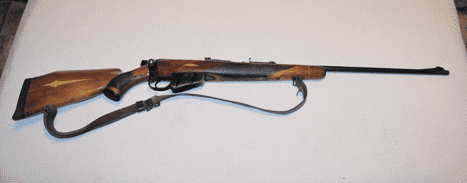
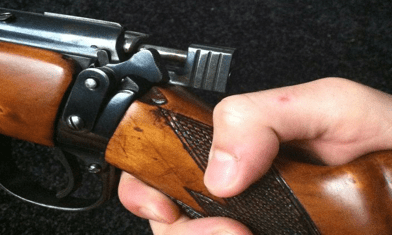
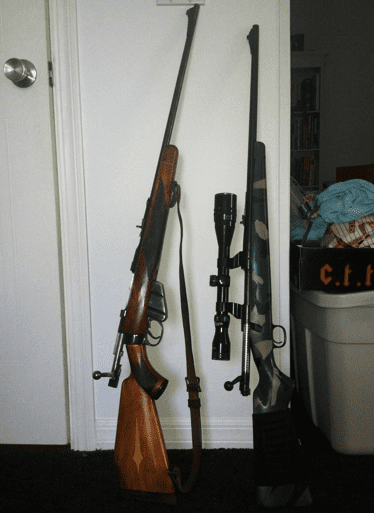
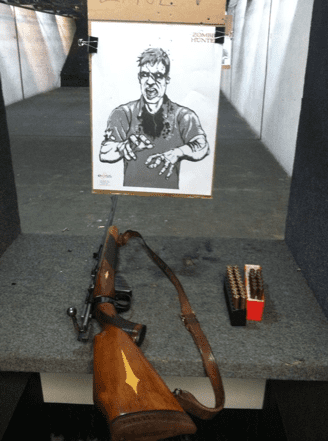



Who imported that? I’ve got my Granddad’s Golden State Arms Model 41 Supreme Enfield sporter, and it looks just like that one, and I couldn’t agree more with your assessment. Great rifles, all of them.
Please, tell me more!! (mods, I’m not a bot, I’m just joshing)
You know I’ve had a hard time finding out which company worked on it. The seller said he thought it was Santa Fe but, Santa Fe was a division of golden state to my (poor) knowledge.
I inherited a sporterized SMLE No4 Mk1* (Savage-built). It’s not nearly at pretty as yours though. One of my next projects to restoring it to original condition.
I’ve got one of those in original condition. It’s a great gun.
Whoever converted it ditched the top barrel covers, an shaved the bottom barrel cover fairly short past where the fore-stock clamp would be. The buttstock is original, brass plate and all, but has seen better days. FORTUNATELY, they never altered the barrel.
Are the savage made guns rare? I have one, it’s not sporterized and has all the original stuff on it. Only shot it a handful of times but love the look to it.
The Mk1* rifles (built either by Savage or Long Branch) are not particularly rare. They were built in the US and Canada to suppliment Commonwealth arms production. It’s more of a distinction for collectors. Prowl the forums and you can find a lot about your rifle. For example I know from the stamps near the serial number that it was factory refurbished after WWII.
A Mk1(T) on the other hand….
A no. 4 should have peep sights on the reciever bridge. The pictures look as though this rifle has a barrel mounted V sight. Am I seeing that right?
As a kid I saw jungle carbines for sale at the local surplus stores for 40 bucks. A wooden barrel full of Arisakas like broom sticks. Dad wouldn’t let me buy the Enfield because of his distrust of foreign made things. My first center fire rifle was a yardsale 03 Springfield that I rode home on my bike with.
I think the jungle carbine is one awesome “little” gun. I’m kicking myself for not buying one in years past; now all the decent ones I’ve come across at gun shows run close to $800 bucks.
I like the .303 chambering for historical correctness, but a jungle carbine in .308 would probably make more sense for me.
Go to gunbroker.com for an Ishapore #2 Mk1 Enfield in .308 converted to jungle carbine length.
I was a kid in the 1950’s but read lots of conversion articles for surplus bolt action rifles. Keeping up with the Joneses in those days meant economizing on guns for most hunters. It was the heyday for J.C. Higgins and Hawthorne firearms as well.
I had 1 of those Ishapore jungle carbine conversions in 7.62 nato when they were selling for 150 bucks at the LGS. 200 round battle packs of surplus ammo were about 50 bucks a pop. Radway ammo from England was about 6 a box.
That carbine patterned like a shotgun ay 50 yards and could barely hold it on the paper at 100. Never liked it.
As a comparison, shooting the Mosin M38 or M44 is a blast — literally — but they do beat you up. OTOH, shooting the jungle carbine is a fast track to bursitis.
I already have a 91/30 and enough cans of Russian ammo to re-fight WWII, so an M44 would be a practical addition.
It was heavily converted the rear sights and charger bridge was removed and it is a after market barrel.
So TTAG does old gun reviews too?
I have a Remington Model 12 which is pretty cool cause it’s probably one of the first ever take down rifles that weren’t single shots. The rifle I have will be turning 85 in a few months too.
I have a Enfield # 5 from down under in 308 Winchester, got it mint for $200. as i reload i have the load for the job i wish , it is a tack driver too. I have kept it as is . to keep it value , I can not see cutting up a military classic..
have a couple MKIV, replaced the stock on one, got the repro canvas slings for em and a spike bayonet.
As a teen I had a savage, they were built and labled US Property to meet the Lend Lease law requirements.
And here I passed up a sporterized Enfield a couple months ago at a really good price, because I knew nothing about it. Guess I missed that boat.
That’s the story of being a gun owner Matt. Unless you just buy the one gun and have no intentions of buying more you will eventually have a long list of the ones that got away. I know I do.
Shouldn’t the MSRP on that be around 10 pounds sterling? Two hundred dollars would have bought a Model T!
I have two Enfields – 1944 Maltby and a 1941 Lithgow. The Maltby is a Mk.2, the Lithgow a Mk.1. It’s a sin to sporterize these rifles !
I have 6 Lee-Enfields. They are great rifles to shoot. I have two in .303, one is a parts bin or future project. The other is full restored original and only gets used in Anzac Day, Lee-Enfield Centenary, and Rememberance Day competitions. Two in .223, one scoped with a S&K mount and the other with a Rawson target sight fitted, and both using 1-in-9″ barrels. Both are tack-drivers that are really cheap to shoot. A M10B (or No4 Mk4) in 7.62. Feeds and extracts flawlessly but the best group has been 4+” at 100 metres. And a No8 .22 Trainer.
All are great fun to shoot and the .303 No4 has brought home the bacon and goat on many occasions. Using an iron-sighted and full-stocked service rifle on hunts does raise a few eyebrows but when you have a herd of pigs, several 10-round magazines and a few stripper clips means I get more shots away and kills on the ground. And the bayonet has been blooded more than a few times as well.
Ya know, I am filled with the nearly irresistible urge to smack people in the head when they butcher an SMLE like that. Ain’t capable of carrying and firing a smelly in full furniture? Then give it to someone who is. Thus endeth the rant.
I own several SMLEs, been using a Savage built one as my primary deer/bear rifle since the early ’90s. Seen a lot of beautifully converted ones, seen a lot more horribly mangled ones. As for hunting loads, you are definitely gonna need to reload your own, most you will find available is 180gr, kinda big for deer, but quite adequate for smackin’ feral hogs. Pick up a good quantity of mil-surplus ammo, preferably Boxer primed, Berdan is a real pain to reload, to work on your marksmanship. And be warned! They kick like a mule and will have corrosive primer/propellant so your cleaning skills will be sharpened, as well.
Oh, and welcome to the wonderful world of .303Brit shooting!
Oh, and look for Sellier&Bellot ammo, they make several weights in .303Brit, round nose, soft point and power point. Not sure if they are still in current production, their brass is excellent for reloading, though.
Just a few months a guy at work got to talking about his English rifle and brought it in. Unfortunately it was sporterized, since it is a 1917 model 1917 year Lee Enfield in great condition. This is my first milsurp. I then got the bug and had to have more, I caught Mosinitus and found M44 and 91/30. Now back to this subject, I have sold that Enfield but have three now, I hate to say sporterized. I have a US Property S no4 Mk1. Next is a 1942 Austraila .303 that is the closest to original since the stock and fore are there but have cut back to about 1in or so ahead of the rear band. Also a British .303 United Kingdom No4 Mk1(F) with synthetic stock and butt. I sold the 1917 but I’ve loved them all and eventhough I just got the synthetic in a trade and haven’t studied it yet it will fall in line with the others I’m sure. When we change the comments to Swiss 1889/96 rifles, count me in and let me know where to go, Thank You.
As soon as I saw this, I thought “GHOST IN THE DARKNESS”.
That is a no 1 not a no4. The receiver is rounded not flat. It never had a rear receiver sight. I’m surprised it doesn’t say on the receiver ring what it is. no4’s had flat sides and a raised area on the rear that mounted the rear battle sight peep sight and flip up ladder sight. It is a really nice conversion though and might shoot good from a bench which is the only way to find out it’s true potential. Off hand is just wasting ammo for me.
Sorry, neither the No. 4 or No. 5 Lee-Enfields are SMLEs. Instead the SMLE nomenclature is reserved for the No. 1 MK III.
Sure, buddy. Whatever.
No, 2hotel9, not whatever, fact.
Yea, whatever.
mine got a parker heyl barral on it good stuff
Slim Fit Leather Jackets is an online store that sells jackets for men and women with free shipping all over the world! Visit Our Site and Get Your Favorite Actors or Actresses Outfits now at the best prices.
Comments are closed.